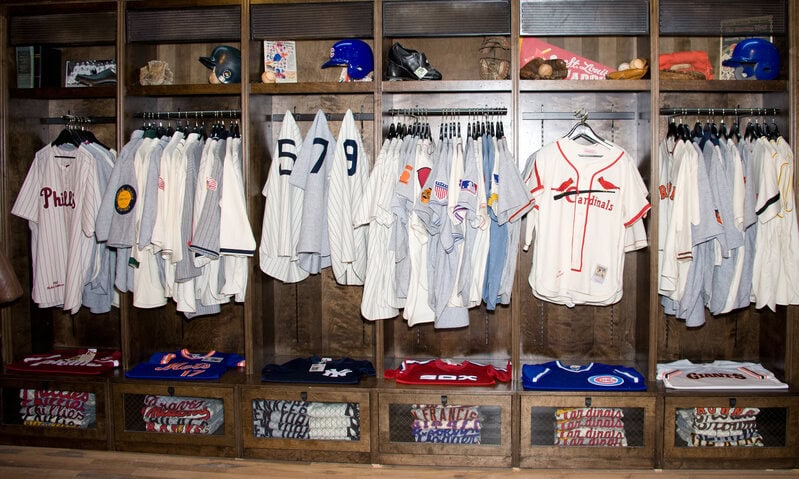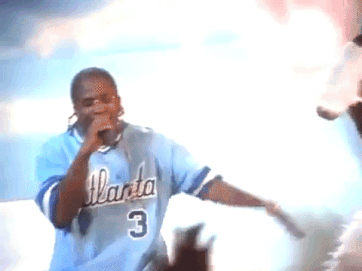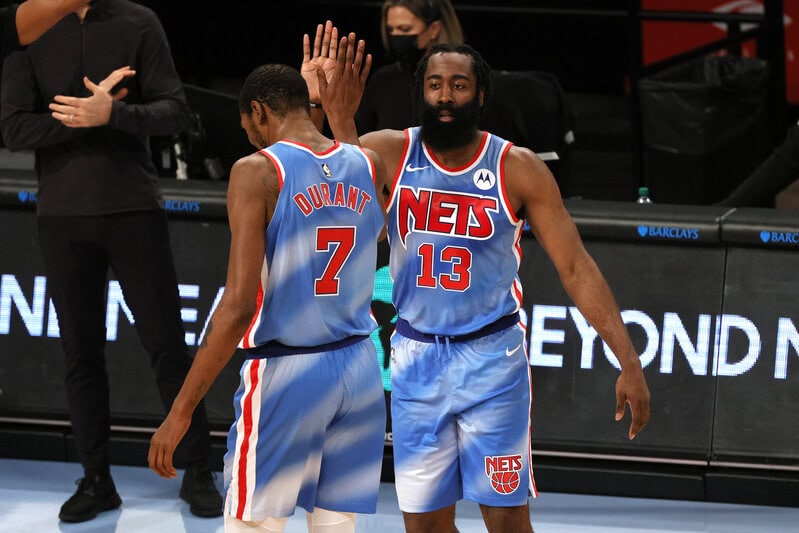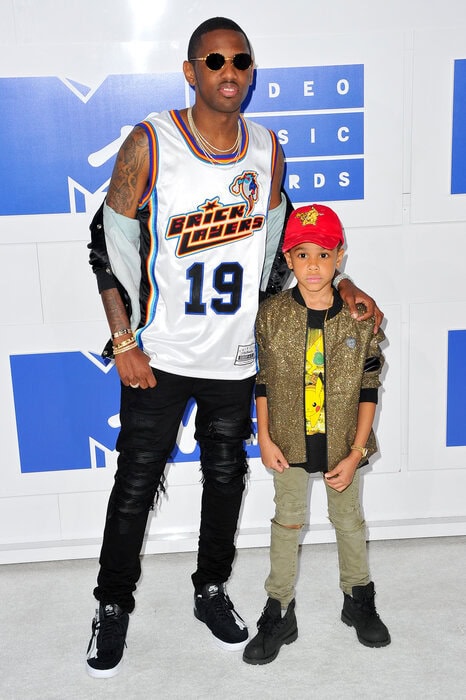In 2003, Jay-Z traded his throwbacks for button-ups. But in the years since then, these looks have experienced a resurgence.
As the clock struck midnight on January 1, 2000, the world waited with anxiously bated breath to see if the dreaded Y2K would be the disaster it was made out to be. Well, not only did the wide digital cosmos survive; they thrived, helping to usher in a future-is-now era of technology, fads, and fashion as the new millennium dawned.
Running shoes with shock absorbers. Pocket-sized MP3 players. Digital pets that needed digital food (or else they digitally died).
This cutting-edge approach to clothing and music and animal companionship was enough to frighten the old folks, and the sheer pace of the changes was enough to burn out even many of those aptly named millennials. There was simply too much “new” too fast. What we needed instead was something classic. Something with a story. Something they didn’t need to Ask Jeeves to understand.
Enter throwback jerseys.

Appearing only occasionally on-court or on-field throughout the 1990s, the throwback as we now know it exploded in exposure in the early 2000s.
See, jerseys were popular in the 90s as fashion items, but they weren’t necessarily a status symbol. If you had a replica fit of your favorite player, you were a fan and you were fly. If you had an authentic — stitching and all — you were not only fly and a fan, you were almost certainly paid.
But by the early 2000s, this all changed with the ascent of the throwback. In short order, the thirst became very, very real. (It has to be if you’re tracking down an archival remake retailing for well over $200.)
Big Boi brought the look some notable attention in the 1998 music video for Outkast’s “Skew It on the Bar-B.” The Atlanta MC bested one of rap’s best dressers, the Wu-Tang Clan’s Raekwon, by rocking a 1982 Dale Murphy Braves jersey by Mitchell & Ness.
This caught the attention of a certain up-and-coming producer from the Midwest, and eventually the biggest rapper in the entire game.

“By the time I got to New York, we had the throwbacks,” Kanye West once told presenter and DJ Zane Lowe. “But really, Big Boi had the throwbacks first. Mitchell & Ness had a little stand at Lenox [Square in Atlanta] and I’d be down there doing beats for Jermaine Dupri. I’d pull up to the stand and grab a throwback. I’d pull up to Bassline and Jay was like, ‘Man, that’s nice!’”
That Jay happened to be Jay-Z. West worked with the Roc-A-Fella MC on his immortal The Blueprint album in 2001, directly connecting hip-hop’s then-king of culture to the aesthetic of the throwback jersey. It was a natural evolution in fashion for Hov, who had become known for wearing the authentic jerseys of active athletes like Shaquille O’Neal, Ray Allen, and Jessie Armstead, among others, for each stop of 1999’s Hard Knock Life Tour.
The soul samples of 2001’s Blueprint played perfectly to the vintage vibe Jay elevated with throwback jerseys. Not only was the old style both new and familiar — it was expensive. At the time, Mitchell & Ness jerseys retailed for much more than that of modern authentic jerseys made by Nike, Reebok, or Majestic.
The lofty price point only added to the allure, with popular musical artists competing for finding the rarest retired players’ jerseys money could procure. For stars like Fabolous, Jermaine Dupri, Cam’ron, and the rest of the rap game, an oversized throwback was the sign of a fat wallet and a keen taste for trends.

Around that same time, a Philadelphia native known as Reuben “Big Rube” Harley began working with Mitchell & Ness, still something of a local brand at the time. While Rube bought his first throwback jersey from M&N all the way back in 1991, it was a decade later when he became the plug for hip hop acts in NYC ranging from Hov to Diddy.
Much like Raekwon and Brand Nubian’s Grand Puba had rebranded Ralph Lauren as a name to be relished by rap royalty in the 1990s, Rube became the bridge for Mitchell & Ness in the 2000s. Originally, M&N was marketed towards wealthy, generally white Baby Boomers. Soon, it was a must-have for the young, flashy and famous.
It was reported that Mitchell & Ness’ sales jumped from just $2.2 million in 1999 to all the way to that of $36 million in 2003. And that span of time lines up almost exactly with Allen Iverson wearing a 76ers throwback on the cover of SLAM in March of ’99 to donning a Bucks Kareem Abdul-Jabbar throwback on the Sixers’ bench a few years later.

At that point, fandom was only part of the equation. Fashion mattered much more.
This quickly changed as professional sports leagues and their sponsors implemented throwback uniforms in gameplay. A Johnny Unitas or Alex English jersey generating more demand than Peyton Manning and Carmelo Anthony wasn’t good for business — so current stars instead began donning the styles of the past themselves. The practice quickly became so common that both the market and marquee matchups were flooded with apparel from the bygone days of sports.
But by 2003, even Jay-Z had shelved his throwback jerseys in favor of more mature button-ups, deading a trend he himself helped kick-start years earlier.
And eventually, the luster was lost. An era was over.
As the 2000s gave way to the 2010s, throwbacks enjoyed fuller lives in video games and at musical festivals than in music videos and actual live sporting events. By comparison, wearing the uniform of a player from the past was less about financial flexing and more and more an expression of, say, frat party irony.
Eventually, it was small brands that began bringing back uniforms with pop culture resonance, representing fictional characters like Bobby Boucher and Al Bundy. Joon, a member of LA hip hop collective OverDoz, was ahead of the curve when it came to representing this manner of Hollywood heritage, while VILLA eventually brought in Fabolous to release a range of retro jerseys ranging from Jamie Foxx’s Willie Beaman of Any Given Sunday to Ray Allen’s Jesus Shuttlesworth from He Got Game.

In 2021, throwback jerseys are not exactly what they were in 2001, but they’re not simply available; they carry prestige. When considering inflation, Mitchell & Ness favorites are still pricey for an authentic, but are also scaled down to swingman styles and sold in about every mall in America — not strictly Lenox.
Moreover, the importance of Nike inking deals with the NBA, NFL, and MLB add to the exposure and creative innovation of athletic apparel, with many of the top teams in each league sporting not throwback jerseys on the regular, but increasingly recognizable alternate looks that could one day level up to throwback status themselves.
Rather than reliving the 70s and 80s as we did in 2000s, designs dating back to the 1990s (and some more recent than that) dominate the current climate for throwback looks. “A purple pinstripe jersey with a dinosaur on it is not something I thought that a lot of people would be clamoring for,” Lynn Bloom, the director of merchandising at Mitchell & Ness, told For the Win of the Toronto Raptors jersey Vince Carter first made famous. “But I was happy to be mistaken.”
Now, two decades after the original rise of the throwback and 21 years since the clock struck 2000 and we all check to see if the family computer still turned on, the appetite for the old is back.
The eras that we now consider “the past” have changed.
The nostalgia that comes with celebrating them has not.